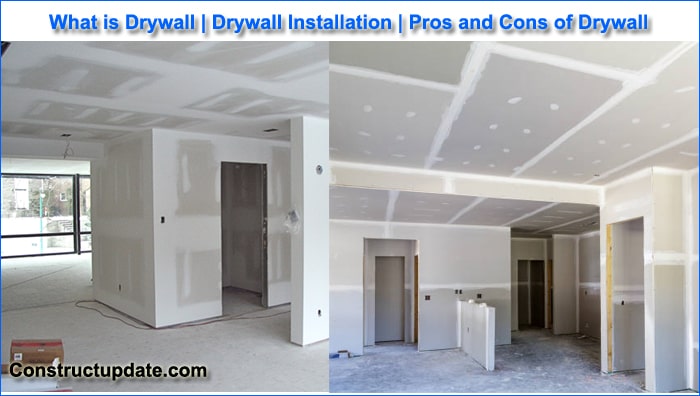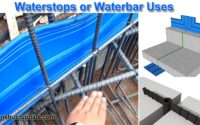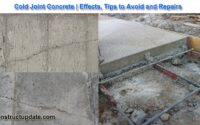What is Drywall | Types of Bathroom Drywall | Drywall Installation Process | Pros and Cons of Drywall Installation
What is Drywall?
Drywall is a type of gypsum board that is used to cover the inner walls of a home. Drywall is also known as gypsum panel, sheetrock, wallboard, custard board, buster board, and other terms.
A gypsum board is sandwiched between two paper boards in drywall. Quick-set gypsum plaster is used to attach them. Foaming agents and plasticizers are sometimes mixed in with the gypsum plaster. Drywall building began in the United States in the early twentieth century to reduce plastering labour costs.
Types Of Bathroom Drywall
Not all drywall is created equal. Understanding the many types of drywall available will help you decide which one to use for your project.

Here are the common niche drywalls:
White Board
The most popular type of drywall is four-by-eight-foot sheets. It’s a popular choice for living rooms, bedrooms, and kitchen designs. The whiteboard has a cardboard colour on one side and is white on the other.
Green Board Drywall
Green board drywall can withstand wetness. It is not, however, waterproof. It’s not the same as cement board, which is more durable and suitable for high-moisture locations such as bathrooms. Green board, on the other hand, is ideal for bathroom walls.
Blue Board Drywall
Plasterboard, often known as blue board, is used as a backing for plastering. It’s also water-resistant, therefore it’s suitable for use in bathrooms and as a tile foundation. You don’t need to tape the mortar to the board.
Purple Board Drywall
Purple board drywall is appropriate for places with a lot of moisture. It costs extra, but it’s a better version of conventional drywall. It’s not water-resistant; it’s waterproof.
Paperless Drywall
Drywall that is free of paper is becoming the new standard. Paper drywall is a type of drywall that can be found in older homes. It’s being used to replace paper-covered drywall, which isn’t water, fire, or mould resistant. It costs more than other types of drywall.
Type X Drywall
Type X drywall is a thicker, fire-resistant drywall. Off-white, or ivory, is the hue of the paper, which sets it apart from other drywalls. Cutting with a drywall knife is difficult and requires the use of a saw.
Insulating Bathroom Drywall
When working on an outside wall, it’s critical to insulate the area before putting up drywall. For colder climates, use thicker insulation; for milder climes, use regular insulation.
Because insulation is dangerous to breathe, cut it outside and wear a mask while putting it inside. If you have asthma, avoid handling the insulation and avoid touching the fluffy area, instead stapling the paper.
Drywall Installation Process
The following are the processes for installing drywall.
- First, we must measure the area where the drywall will be installed. Measure the entire length, height, and width of the area.
- Second, draw a proper diagram of that location, including all of the measured heights.
- The drywall must then be installed. The white marking sign, which must be on the upward side of the drywall, must be taken into consideration. For proper straight-line marking, please use a scale.
- The purpose employs a utility knife for scoring, but don’t press too hard because it will go deeper and cross the firm line, causing extra complications.
- It will make a good bump in the back sight after scoring, and it will cut in half at the scoring point.
- Then we’ll need to cut the back paper that’s attached to the drywall with a utility knife.
After that, we’ll take it to the testing location. - After comprehensive testing, utilise screws for assembly; nevertheless, you must ensure that the spacing and interval of those screws are correct, or else a slew of issues will arise.
- Use enough screws to keep the drywall from cracking.
Pros And Cons Of Drywall
Because there are so many alternative interior wall options, it’s crucial to be sure that drywall is the appropriate choice for you.
Pros
Easy To Install – Drywall is one of the most straightforward materials to work with. You can finish a complete room in a few of hours if you know how to use a knife and a drill. It will not be finished, but it will be operational.
Cheap – This is the primary reason behind drywall’s popularity. It is one of the most affordable wall coverings on the market. White board drywall costs roughly $.50 per square foot. Use this calculator to figure out how much wall space you have.
Stable – Because the pieces are so huge, drywall is fairly sturdy. The majority of drywall is installed in four-foot sections at a time. Because most studs are 16 inches long, putting screws every 16 inches provides a lot of stability. Which is exactly what you should do in order to achieve the finest results.
Lots Of Resistant Options – There’s a drywall choice for you, whether you require fire-resistant drywall behind your oven or water-resistant drywall behind your sink. You can cover every space in your house with so many alternatives.
Easy To Repair – It is possible to repair drywall if it is damaged. A simple drywall repair kit can help unless the damage is severe. Find the most cost-effective drywall repair kit.
Can Be Painted – The drywall can be painted over and over again. It can also take wallpaper, so if you’re weary of painted walls or want to hide a sloppy mud job, you may cover it with wallpaper.
Compatible With Drywall Screws – Without the extra support of a stud, you can hang just about anything using drywall screws and anchors. Although using a stud is preferred, an anchor might assist you in reaching that stud.
Cons
Difficult To Finish – Although drywall is simple to install, finishing it may be challenging. On the mudding, flush everything.
Heavy – If you don’t want dented corners from dropping drywall, you’ll need a crew lift. Each piece is around 50 pounds in weight. Furthermore, most drywall comes in two pieces that must be broken apart, resulting in a weight of more than 100 pounds.
Not Very Durable – Although drywall is a durable material, it is susceptible to breakage. Even a slammed door can rip the drywall and leave a hole the size of a doorknob. Most drywall will need to be repaired once or twice a year.
Not Authentic – For most walls, drywall is a fantastic alternative, but if you want something that feels handcrafted and true, it’s not for you. Drywall can be contemporary and painted in any hue, but it has an artificial feel to it.
Needs Outside Area To Work With – If you’re going to hang drywall, you’ll need a large outdoor space. Cutting drywall inside is not only inconvenient, but also dangerous. Dust particles require air to escape or they will become stuck indoors.
Hard To Choose Type – You want to make sure you get the most bang for your buck because there are so many different varieties of drywall with such a wide range of prices.





